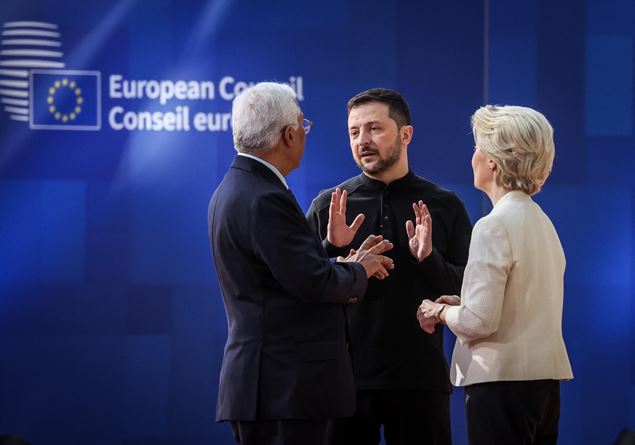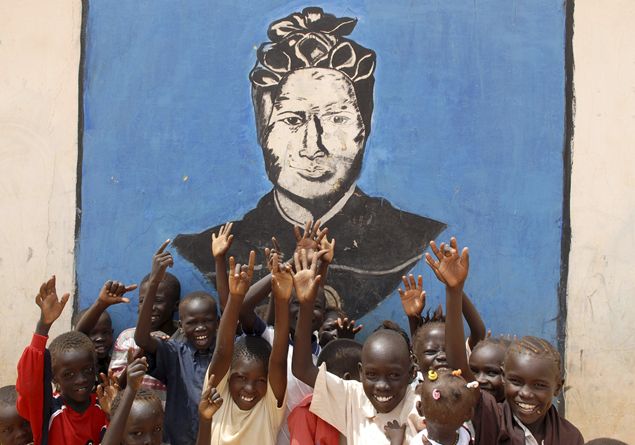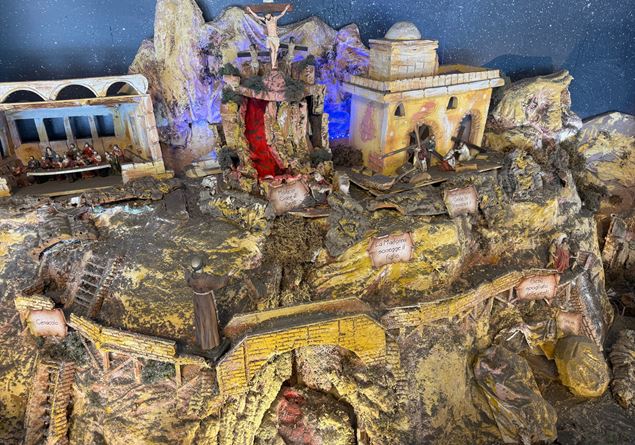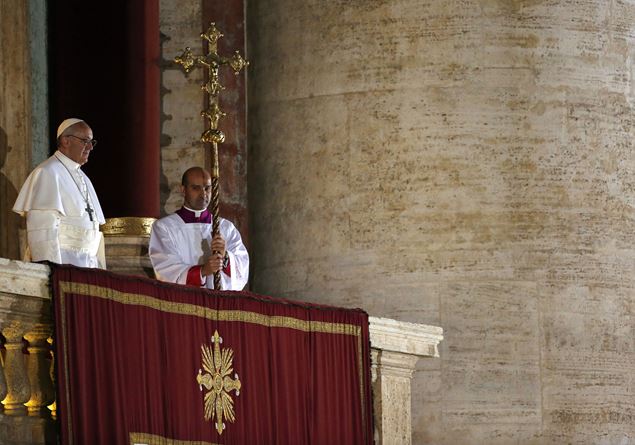We can define it the first non -EU citizen elevated to the honor of the altars. The extremely engaging story of the Sudanese Giuseppina Bakhita seems almost out of a novel.
His family – parents, three brothers and three sisters – lived in a Darfur village, near Monte Agilere. The uncle was head of the village. Presumably born in 1869, the opening year of the Suez canal, around 8-9 years it was kidnapped by two Arabs while gathering herbs in a field near home. “If you cries you are dead,” one threatened her armed with rifle, pushing her violently into the dense bush.
After walking all night, the girl was locked up in a bugiga downs: “I called mom and dad”, she will later tell the nun in a memory drawn up at the invitation of the Superior, “with an anguish of mind not to say. But nobody heard me. More: silence was ordered with terrible threats “. He was so terrified that he even forgot his name: the two negryers called it “Bakhita” that – ironically – it means lucky.
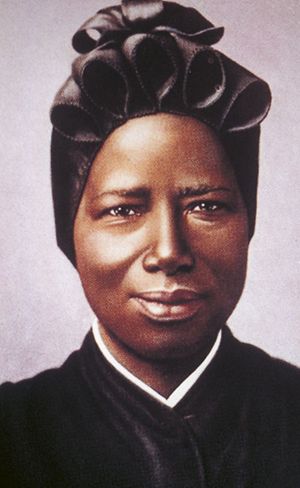
In the hands of the Negrietri, she ended up being “bought” by an Italian consular agent
Three years earlier, in the same way her older, married and mother of a son had also been kidnapped, of whom nothing would have been known. The slave market was then flourishing, despite that in the first half of the 19th century almost all European powers and the United States had decreed by law the end of trafficking and slavery. They were above all Arab nomadic shepherds from Kordofan who devoted themselves to the kidnapping of children and young women for northern market markets.
During his imprisonment, after the owner had removed his chains for his corn to span more quickly, Bakhita managed to escape together with a partner, but fell into the hands of another negry and was then sold and resold to several families, subject to suffering of all kinds.
In Khartoum he was bought by a Turkish general, but had to suffer serious mistreatment from his daughters and his son and finally, by order of the mistress, the torture of the tattoo: A sorceress with a razor practic six engravings on the chest, 60 on the belly and 48 on the whole body, about one centimeter deep, Inside which salt grains were put because the scars were always visible. The girl remained for several days between life and death.
Before returning to Türkiye, the general put the slave on the market: A Italian consular agent took this, this Calisto Legnani, who drew it as a maid, also helping her to trace her family, unfortunately without outcome.
The girl remained at his house until 1884, when the European Championships of Khartoum decided to leave Sudan in front of the advance of the Mahdisti rebels. Bakhita got to accompany Legnani to Italy, who then gave Maria Turina, his Russian wife of Augusto Michieli, an Italian friend who traveled with him.
With the new masters, Bakhita moved to Mirano Veneto: she was the “nanny” in Mimmina, their girl of about three years old, who fell very much. Everyone returned to Sudan in Suekin where the Michieli managed a hotel, determined to remain definitively, but the Turina, having to return to Italy to sell the family properties and pack the furniture for the move, wanted Bakhita and Mimmina accompanied it.
In the spring of 1885, the former slave illuminated Checchini, the Michieli house factor, fervent organizer of Catholic associations, promoter and founder of rural coffers and mutual insurance, friend of Don Giuseppe Sarto, future Pope Pius X.
It was he who brought Bakhita to the Christian faith. Maria Turina, having to temporarily reach her husband to Suakin to agree on the latest economic obligations, left the domestic in Italy and Mimmina, Hiring them at the Catechumeni Institute managed by the daughters of Charity (Canossian) in Venice.
Here Checchini made a small silver crucifix in Bakhita: “In give it to me”, says the saint, “kissed him with devotion, then he explained to me that Jesus Christ, son of God, had died for us. I didn’t know what it was, but pushed by a mysterious force, I hid him for fear that the lady would take it to me (the Turina was substantially atheist). Before I had never hidden anything because I was not attached to anything. I remember that I was hiddenly looked at him and I felt something in me that I didn’t know how to explain. “
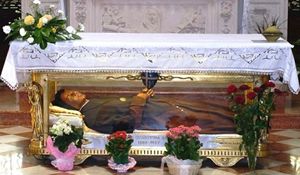
The mortal remains of Santa Giuseppina Bakhita
In 1890 he was baptized and in 1927 he was a perpetual profession
The Daughters of charity They educated Bakhita in the truths of the faith in which, despite the difficulties of language, he made such progress as to want baptism soon. At this point – we are in 1889 – Maria Turina was again in Italy to prepare for the definitive departure: the girl realized that returning to Africa she would risk losing the faith and decided to remain, causing a very hard reaction from Michieli, who even resorted to To the King’s prosecutor, but unnecessarily: “Being in Italy” – this is the response of the prosecutor – “where the slave market is not made, the young woman remains free at all”.
He was baptized on January 9, 1890 with the names of Giuseppina, Margherita and Fortuna. On the same day he was created and made his first communion. He remained two more years in the institute, where he matured his religious vocation among the Canossian.
Entering the Novitiate in December 1893, he made his first profession three years later in Verona. Shortly before, he had been examined about his vocation from the Patriarch of Venice Cardinal Sarto who had said to her: “He pronounces the sacred votes without fear: Jesus loves you. Jesus loves you. You too love it and always serve it so ”.
The profession perpetual will do it only in 1927, in the chapel of the Mirano Veneto branch house. In Venice he spent his days in the girls’ laboratory working at the irons and embroidering.
In 1902 he was transferred to Schio with the assignment before the kitchen, then of the sacristy and finally of the concierge, who always exercised promptly, simplicity and affability. “Mother Moretta”, as people called her, always had a good word (in Veneto dialect, the only language she knew) and a smile for everyone.
In 1935, together with a sisted that had been many years in China, a series of missionary animation trips began. One day, during the last war, he refused to go to the refuge while the allies bombed the city: Everyone was convinced that, thanks to her, Schio would not have suffered damage, and so it happened. Then, over the years, he began to resent brutality (especially kicks and staff) suffered by slave: he was first hit by elephantiasis, then by serious forms of arthritis, bronchial asthma and bronchopneumonia.
Now forced to a wheelchair, he spent entire hours in prayer in front of the tabernacle offering his sufferings for the church, for the Pope and for the conversion of sinners.
He died on February 8, 1947 after exclaiming: “How happy I am … the Madonna, the Madonna”. His body kept flexible so much so that the mothers took the arm of “Mother Moretta” and lay him on the head of the children to obtain the protection. His tomb was soon besieged by faithful who resorted with surprising results to his intercession.
Blessed by John Paul II on May 17, 1992, he was canonized by him on 1 October 2000.
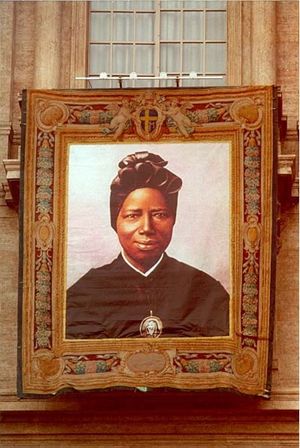
The Holy icon during canonization in St. Peter’s Square of 1 October 2000
The miracle of Santa Bakhita: he saved a woman from the amputation of the limbs
The canonization process began in 1959, just 12 years after death.
For the purposes of canonization, the Church considers a second miracle necessary, after that requested for beatification: in the case of Giuseppina Bakhita, she considered the case of Eva da miraculous Costa Onishihealed in 1992 by infected ulcerations in the lower limbs, caused by diabetes and hypertension. Eva da Costaborn on January 1, 1931 in Iguape (Brazil), in 1950 she married Yoziro Onishi, of Japanese origin, from whom she had had four children, subsequently separating.
Established with the younger son in the poor neighborhoods of Santos, he had become diabetic since 1976. In 1980 deep sores had appeared in the legs, diagnosed as infected ulcerations in subject with diabetes mellitus, hypertension and chronic insufficiency of the venous circle. The precarious economic conditions did not allow her to take care adequately, and the amputation was expected.
In 1992, the year of the beatification of Giuseppina Bakhita, participating on May 27 in a meeting of the “elderly women” in the cathedral of Santos, invoked the help of Blesata Bakhita. Returning home, he realized that the wounds, one of which came to the bone, had suddenly disappeared and the skin was renewed.
The case, after the diocesan process, was subjected to Congregation for the causes of the saints Which, on December 21, 1998, promulgated the decree on the miracle, declaring the inexplicability of healing, quick, complete and lasting on 1 October 2000 Eva da Costa participated, in St. Peter’s Square, in the canonization ceremony of the Blessed Giuseppina Bakhita.
The saint was remembered by Pope Benedict XVI in the encyclical Spe Salvi Remembering her as an example of Christian hope: “Through the knowledge of hope she was” redeemed “, she was no longer felt slave but free daughter of God”.





